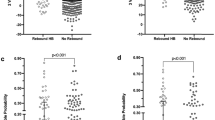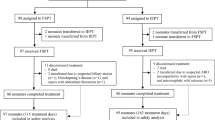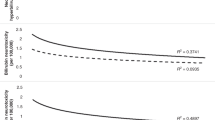Abstract
Objective
To evaluate the feasibility of auditory monitoring of neurophysiological status using frequency-following response (FFR) in neonates with progressive moderate hyperbilirubinemia, measured by transcutaneous (TcB) levels.
Study design
ABR and FFR measures were compared and correlated with TcB levels across three groups. Group I was a healthy cohort (n = 13). Group II (n = 28) consisted of neonates with progressive, moderate hyperbilirubinemia and Group III consisted of the same neonates, post physician-ordered phototherapy.
Result
FFR amplitudes in Group I controls (TcB = 83.1 ± 32.5µmol/L; 4.9 ± 1.9 mg/dL) were greater than Group II (TcB = 209.3 ± 48.0µmol/L; 12.1 ± 2.8 mg/dL). After TcB was lowered by phototherapy, FFR amplitudes in Group III were similar to controls. Lower TcB levels correlated with larger FFR amplitudes (r = −0.291, p = 0.015), but not with ABR wave amplitude or latencies.
Conclusion
The FFR is a promising measure of the dynamic neurophysiological status in neonates, and may be useful in tracking neurotoxicity in infants with hyperbilirubinemia.
This is a preview of subscription content, access via your institution
Access options
Subscribe to this journal
Receive 12 print issues and online access
$259.00 per year
only $21.58 per issue
Buy this article
- Purchase on SpringerLink
- Instant access to full article PDF
Prices may be subject to local taxes which are calculated during checkout



Similar content being viewed by others
References
Downs MP. Universal newborn hearing screening–the Colorado story. Int J Pedia Otorhinolaryngol. 1995;32:257–9.
Jacobson GP. Universal newborn hearing loss: screening, identification, intervention. Am J Audio. 2001;10:52.
Boo NY, Oakes M, Lye MS, Said H. Risk factors associated with hearing loss in term neonates with hyperbilirubinaemia. J Trop Pedia. 1994;40:194–7.
Ortiz-Mantilla S, Choudhury N, Leevers H, Benasich AA. Understanding language and cognitive deficits in very low birth weight children. Dev Psychobiol. 2008;50:107–26.
Jiang ZD, Wilkinson AR. Impaired function of the auditory brainstem in term neonates with hyperbilirubinemia. Brain Dev. 2014;36:212–8.
Fenwick JD. Neonatal jaundice as a cause of deafness. J Laryngol Otol. 1975;89:925–32.
Shapiro SM, Popelka GR. Auditory impairment in infants at risk for bilirubin-induced neurologic dysfunction. Semin Perinatol. 2011;35:162–70.
Johnson L, Bhutani VK. The clinical syndrome of bilirubin-induced neurologic dysfunction. Semin Perinatol. 2011;35:101–13.
Nakamura H, Takada S, Shimabuku R, Matsuo M, Matsuo T, Negishi H. Auditory nerve and brainstem responses in newborn infants with hyperbilirubinemia. Pediatrics. 1985;75:703–8.
Agrawal VK, Shukla R, Misra PK, Kapoor RK, Malik GK. Brainstem auditory evoked response in newborns with hyperbilirubinemia. Indian Pedia. 1998;35:513–8.
Amin SB, Ahlfors C, Orlando MS, Dalzell LE, Merle KS, Guillet R. Bilirubin and serial auditory brainstem responses in premature infants. Pediatrics. 2001;107:664–70.
Berlin CI, Hood LJ, Morlet T, Wilensky D, Li L, Mattingly KR, et al. Multi-site diagnosis and management of 260 patients with auditory neuropathy/dys-synchrony (auditory neuropathy spectrum disorder). Int J Audio. 2010;49:30–43. https://doi.org/10.3109/14992020903160892
Smith JC, Marsh JT, Brown WS. Far-field recorded frequency-following responses: evidence for the locus of brainstem sources. Electro Neurophysiol. 1975;39:465–72.
Gardi J, Merzenich M, McKean C. Origins of the scalp recorded frequency-following response in the cat. Audiology. 1979;18:358–81.
Sohmer H, Pratt H, Kinarti R. Sources of frequency following responses (FFR) in man. Electroencephalogr Clin Neurophysiol. 1977;42:656–64.
Hoormann J, Falkenstein M, Hohnsbein J, Blanke L. The human frequency-following response (FFR): normal variability and relation to the click-evoked brainstem response. HearRes. 1992;59:179–88.
Anderson S, Parbery-Clark A, White-Schwoch T, Kraus N. Development of subcortical speech representation in human infants. J Acoust Soc Am. 2015;137:3346–55.
Musacchia G, Ortiz-Mantilla S, Roesler CP, Rajendran S, Morgan-Byrne J, Benasich AA. Effects of noise and age on the infant brainstem response to speech. Clin Neurophysiol. 2018;129:2623–34.
Krishnan A, Xu Y, Gandour J, Cariani P. Encoding of pitch in the human brainstem is sensitive to language experience. Cogn Brain Res. 2005;25:161–8.
Cunningham J, Nicol T, King C, Zecker SG, Kraus N. Effects of noise and cue enhancement on neural responses to speech in auditory midbrain, thalamus and cortex. Hear Res. 2002;169:97–111.
Russo N, Nicol T, Musacchia G, Kraus N. Brainstem responses to speech syllables. Clin Neurophysiol. 2004;115:2021–30.
Musacchia G, Sams M, Skoe E, Kraus N. Musicians have enhanced subcortical auditory and audiovisual processing of speech and music. Proc Natl Acad Sci USA. 2007;104:15894–8.
Musacchia G, Strait D, Kraus N. Relationships between behavior, brainstem and cortical encoding of seen and heard speech in musicians and non-musicians. Hear Res. 2008;241:34–42.
Kraus N, Lindley T, Colegrove D, Krizman J, Otto-Meyer S, Thompson EC, et al. The neural legacy of a single concussion. Neurosci Lett. 2017;646:21–23.
Cunningham J, Nicol T, Zecker SG, Bradlow A, Kraus N. Neurobiologic responses to speech in noise in children with learning problems: deficits and strategies for improvement. Clin Neurophysiol. 2001;112:758–67.
King C, Warrier CM, Hayes E, Kraus N. Deficits in auditory brainstem pathway encoding of speech sounds in children with learning problems. Neurosci Lett. 2002;319:111–5.
Wible B, Nicol T, Kraus N. Atypical brainstem representation of onset and formant structure of speech sounds in children with language-based learning problems. Biol Psychol. 2004;67:299–317.
Du L-z. Neonatal hyperbilirubinemia diagnosis and treatment expert consensus. Chin J Pedia. 2014;52:745–8.
Hall JW 3rd. Anatomy and Physiology Principles of Auditory Evoked Responses. New Handbook of Auditory Evoked Responses. Needham Heights, MA: Allyn and Bacon; 2007. p. 41–47.
Hall JW 3rd, Rupp KA. Auditory brainstem response: recent developments in recording and analysis. Adv Otorhinolaryngol. 1997;53:21–45.
Issa A, Ross HF. An improved procedure for assessing ABR latency in young subjects based on a new normative data set. Int J Pedia Otorhinolaryngol. 1995;32:35–47.
Musacchia G, Sams M, Nicol T, Kraus N. Seeing speech affects acoustic information processing in the human brainstem. Exp Brain Res. 2006;168:1–10.
Klatt DH. Software for a cascade/parallel formant synthesizer. J Acoust Soc Am. 1980;67:971–95.
Skoe E, Krizman J, Anderson S, Kraus N. Stability and plasticity of auditory brainstem function across the lifespan. Cereb Cortex. 2015;25:1415–26.
Jeng FC, Schnabel EA, Dickman BM, Hu J, Li X, Lin CD, et al. Early maturation of frequency-following responses to voice pitch in infants with normal hearing. Percept Mot Skills. 2010;111:765–84.
Worden FG, Marsh JT. Frequency-following (microphonic-like) neural responses evoked by sound. Electro Neurophysiol Suppl. 1968;25:42–62.
Song JH, Nicol T, Kraus N. Test-retest reliability of the speech-evoked auditory brainstem response. Clin Neurophysiol. 2011;122:346–55.
Bhagat S The Freqency Following Response. In: Atcherson SS,TM (ed). Auditory Eletrophysiology Thieme: NY, NY, 2012, pp 86–102.
Bidelman GM. Subcortical sources dominate the neuroelectric auditory frequency-following response to speech. Neuroimage. 2018;175:56–69.
Chandrasekaran B, Kraus N. The scalp-recorded brainstem response to speech: neural origins and plasticity. Psychophysiology. 2010;47:236–46.
Coultrap SJ, Bayer KU. CaMKII regulation in information processing and storage. Trends Neurosci. 2012;35:607–18.
Shapiro SM, Nakamura H. Bilirubin and the auditory system. J Perinatol. 2001;21(Suppl 1): S52–55. discussion S59-62
Churn SB, DeLorenzo RJ, Shapiro SM. Bilirubin induces a calcium-dependent inhibition of multifunctional Ca2+/calmodulin-dependent kinase II activity in vitro. Pediatr Res. 1995;38:949–54.
Uboha NV, Flajolet M, Nairn AC, Picciotto MR. A calcium- and calmodulin-dependent kinase Ialpha/microtubule affinity regulating kinase 2 signaling cascade mediates calcium-dependent neurite outgrowth. J Neurosci. 2007;27:4413–23.
Eggermont JJ. Physiology of the Developing Auditory System. In: Trehub SES,B (ed). Auditory Development in Infancy Springer: Switzerland, 1985, pp 21–45.
Eilers RE. Infant Speech Perception. Auditory Development in Infancy. Switzerland: Springer; 1985. p. 197–213.
Campbell DM, Danayan KC, McGovern V, Cheema S, Stade B, Sgro M. Transcutaneous bilirubin measurement at the time of hospital discharge in a multiethnic newborn population. Paediatr Child Health. 2011;16:141–5.
Banai K, Nicol T, Zecker SG, Kraus N. Brainstem timing: implications for cortical processing and literacy. JNeurosci. 2005;25:9850–7.
Acknowledgements
We thank Ms. Yaofang Hu and Drs. Anna Zhdamirova, Esther Pugh, and Hayley Shillington for their assistance in data collection.
Funding
This work was supported in part by the Department of Audiology at University of the Pacific and the Department of Pediatrics at the Nanjing Maternal and Child Health Hospital Associated to Nanjing Medical University.
Author information
Authors and Affiliations
Corresponding author
Ethics declarations
Conflict of interest
The authors declare that they have no conflict of interest.
Additional information
Publisher’s note: Springer Nature remains neutral with regard to jurisdictional claims in published maps and institutional affiliations.
Rights and permissions
About this article
Cite this article
Musacchia, G., Hu, J., Bhutani, V.K. et al. Frequency-following response among neonates with progressive moderate hyperbilirubinemia. J Perinatol 40, 203–211 (2020). https://doi.org/10.1038/s41372-019-0421-y
Received:
Revised:
Accepted:
Published:
Issue date:
DOI: https://doi.org/10.1038/s41372-019-0421-y
This article is cited by
-
TcB, FFR, phototherapy and the persistent occurrence of kernicterus spectrum disorder
Journal of Perinatology (2020)



